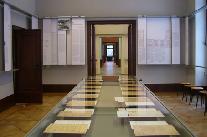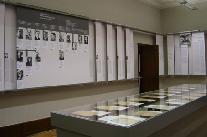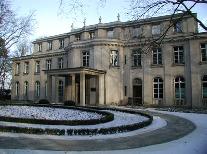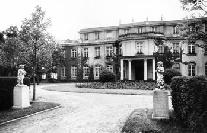EUROPE
House of the Wannsee Conference (Germany)
(Sept. 22, 2010)
by Norbert Kampe, Director
The historical site
In this house – a former industrialist's villa built in 1915 and used from 1941 to 1945 by the SS as a conference centre and guest house – on 20th January 1942, fifteen high-ranking representatives of the SS, the NSDAP and various ministries met to discuss their cooperation in the planned deportation and murder of the European Jews.
The SS representatives reported to the state secretaries present on the murder campaigns which had been carried out by special units in the Soviet Union since August 1941 and on the killing methods already in use.
What is today referred to as the 'Wannsee Conference' was chaired by Reinhard Heydrich, Head of the Reich Security Main Office (RSHA). His deportation expert Adolf Eichmann drew up a protocol of the meeting, which was found in 1947 in the foreign ministry files. The Wannsee Protocol documents with alarming clarity the plan to murder all European Jews and the active participation of Germany's public administration in this genocide.
The educational department
The memorial and educational site offers youth groups and school classes a number of possibilities for studying the persecution and murder of European Jews and the history of National Socialism, its prehistory and consequences. They can explore the permanent exhibition with the help of a specialist guide or by working in small groups supervised by staff members. Study days provide the option of choosing specific subjects to work on under expert instructions. Vocationally oriented study days and several-day seminars are offered to adults engaged in political education or vocational training, instructors and teachers. The house also offers trainee teachers and school teaching staff seminars on memorial education and its use in teaching various subjects.
Permanent exhibit
Situated in the rooms on the ground floor of the villa, the permanent exhibition, entitled "The Wannsee Conference and the Genocide of the European Jews," documents the prehistory of the National Socialist persecution of Jews, the process of social exclusion, deprivation of rights and expulsion between 1933 and 1939, and the deportations, confinement to ghettos and murder of the European Jews in German-controlled territories. The central focus of the exhibition is the conference which took place on 20th January 1942 in the former dining room of the villa. Short texts in German and English inform the visitor of these events, which are recorded in documents from the perpetrators’ files as well as victims’ statements, photographs; sound and film recordings. The history of the building is portrayed in the former caretaker’s apartment. The exhibition catalogue can be purchased on site.
The history of the building
1914/15 Built as a villa residence of factory owner Ernst Marlier
1921 Sold to industrialist Friedrich Minoux
1940 Purchased by the SS Nordhav foundation and set up as a guest house for the
SS Security Service
1942 20th January, Wannsee Conference
1943 Sold to the Reich Security Main Office [Reichssicherheitshauptamt] (RSHA)
1945/46 Used by Allied military
1947-51 August Bebel Institute (Adult education centre)
1952-88 Country hostel for schools from the West Berlin district of Neukölln
1965-72 Attempts by historian Joseph Wulf to found a documentation centre
in the villa fail
1992 Inauguration of the Memorial and Educational Site on the 50th anniversary of
the Wannsee Conference
2006 Opening of the new permanent exhibit
The library / media resource centre
The library is named after the historian Joseph Wulf (1912-1974) who – unsuccessfully - tried to establish a documentation center on National Socialism in the house. The collection consists of a reference library, a collection of microfilmed documents, and audio-visual material. It contains research literature, reference works, memorial books, eye-witness reports, memoirs, literary works, books for children and young adults as well as research periodicals on subjects including the History of the Jews in Europe, Anti-Semitism, Persecution and Genocide, comparative Genocide Studies, National Socialism, the treatment of Nazi history after 1945, and the pedagogy in memorial sites. Much of the library's collection is in languages other than German. The audio-visual material cover the same range of topics as the books and periodicals. The collection has 28,000 volumes and subscribes to 100 periodicals.
Address: Am Grossen Wannsee 56-58, D-14109 Berlin / Germany
Phone: +49-30-80- 50 01 0
Homepage: www.ghwk.de
Days closed: Good Friday, May 1st, Ascension Day, October 3rd, December 24-26, December 31st, January 1st
Admission: Free
(Originally published on September 20, 2010)
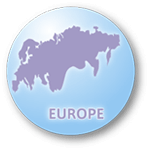 Peace Museums of EUROPE
Peace Museums of EUROPE
